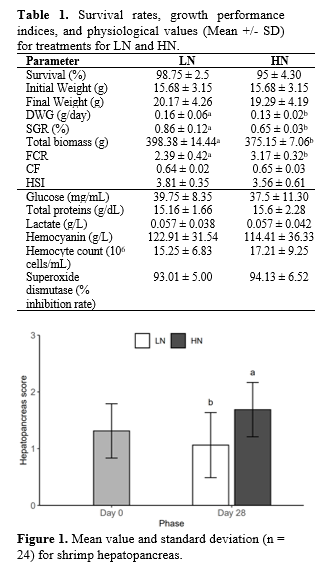EFFECTS OF CHRONIC NITRATE STRESS ON Litopenaeus vannamei REARED IN INDOOR AQUACULTURE SYSTEMS
Introduction
According to FAO [1] , Litopenaeus vannamei production is rapidly expanding (6.8 million tons) due to its palatability, high nutritional value, disease resistance, and rapid growth. To enhance environmental sustainability and biosecurity, indoor aquaculture systems are emerging, minimizing water discharge, but increasing total suspended solids, ammonia, nitrite, and nitrate. Although nitrate originating from the oxidation of ammonia and nitrite is less harmful, it is often disregarded in farm management. In chronic stress conditions, the safe level threshold for W hiteleg shrimp is set to 177 mg/L and [2] , with its toxicity depending on factors such as concentration, salinity and duration of exposure [3] . With increasing aquaculture production, consumer concerns about animal welfare have grown. Physiological and morphological changes provide valuable insights into the effects of stress on shrimp welfare, as markers of compromised health [4] . Currently, limited information is available regarding L. vannamei chronic nitrate stress, with a lack of knowledge about its impact on welfare. This study investigates the effects of chronic nitrate induced stress on L. vannamei , adopting a comprehensive approach that includes growth performance, physiological responses, and overall health.
Materials and methods
The experiment was conducted in 8 separate stand-alone tanks filled with 600 L of saltwater (20 ppt). An airlift-operated biofilter with 30L bio-carriers was installed in each tank to establish biofiltration, water movement and gas exchange. Nitrate concentrations were adjusted to two treatment concentration, low: 50 mg/L (LN) and high: 400 mg/L (HN) NO₃-N, using sodium nitrate (Carl Roth GmbH, Germany) with four replicates per treatment, for a duration of 4 weeks. Nitrate was measured using a nitrate analyzer probe (subCtech GmbH, Kiel, Germany) and adjusted twice a week to the nominal concentration. Shrimp were counted and weighed for the calculation of biometric indices and growth performance, including survival rate (SR), daily weight gain (DWG), specific growth rate (SGR), feed conversion ratio (FCR), condition factor (CF), and hepatosomatic index (HSI). Hemolymph samples were analysed for glucose and protein in a Fuji DRI-Chem NX500i (Fujifilm Europe) blood analysis system. Plasma lactate levels were quantified with an enzymatic kit (L-lactate, Megazyme). Hemocyte count was done using a light microscope and Neubauer chamber. Hemocyanin was measured following the methods of Chen and Cheng (1993). Hepatopancreas samples were diluted, homogenized in a phosphate buffer and superoxide dismutase (SOD) activity was measured with a SOD determination kit (no. 19160, Sigma-Aldrich, St. Louis, MO). Health parameters were assessed using a non-invasive scoring system for different body areas, originated from literature with slight modifications. Independent sample t-tests, Wilcoxon test, Welch’s T-test, Mood median test were used to analyse the difference between the 2 treatments according to the assumptions.
Results and Discussion
No difference was detected in the survival rate between treatments. Variations with other studies may be attributed to differences in salinity, exposure duration, and size which are key factors influencing chronic nitrate toxicity in L. vannamei [3]. However, HN impacted the growth performance (SGR, biomass, DWG) and FCR. The growth performance was in line with data reported from this species. As such, reduced feed utilization related to chronic nitrate stress suggests that energy is shifted from growth related processes towards restoration of homeostasis and acclimatization to the altered environment. No significant differences were observed in the physiological parameters analyzed in the hemolymph (glucose, lactate, total proteins, hemocyanin, and hemocyte count) and in the hepatopancreas (SOD activity). These values were comparable to those from unstressed shrimps in other studies. The health index revealed no significant differences, with only the hepatopancreas quality mildly impaired between LN (1.06 ± 0.62) and HN (1.69 ± 0.79). The visual observation of hepatopancreas quality was associated with a change in color from dark brown to pale and a shift in tecture from firm to mushy.
The relative abundance of opportunistic pathogens, such as Vibrios, has been observed in chronic nitrite stress. These bacteria are reported to alter the phenotype of the hepatopancreas [5], with possibly similar effects during nitrate stress. Overall, the observed effects in this study were not associated with clearly noticeable changes in welfare-related physiological indicators , resulting in only minimal implications for health. However, under high nitrate concentrations realistic for RAS-based shrimp farming, the growth performance of the animals decreases , reducing the productivity.
References
- FAO (2024). The state of world fisheries and aquaculture 2024: Blue transformation action. FAO.
- Furtado, L. S., Campos, B. R., Serra, F. L., Klosterhoff , M., Romano, L. A., & Wasielesky , W. (2015). Effects of nitrate toxicity in the Pacific white shrimp, Litopenaeus vannamei , reared with biofloc technology (BFT). Aquaculture International, 23(1), 315–327.
- Kuhn, D. D., Smith, S. A., Boardman, G. D., Angier, M. W., Marsh, L., & Flick, G. J. (2010). Chronic toxicity of nitrate to Pacific white shrimp, Litopenaeus vannamei : Impacts on survival, growth, antennae length, and pathology. Aquaculture, 309(1–4), 109–114.
- Pedrazzani , A. S., Cozer , N., Quintiliano , M. H., Tavares, C. L. dos S., da Silva, U. de A. T., & Ostrensky , A. (2023). Non-Invasive Methods for Assessing the Welfare of Farmed White-Leg Shrimp (Penaeus vannamei ). Animals, 13(5).
- Huang, M., Xie , J., Yu, Q., Xu, C., Zhou, L., Qin, J. G., & Li, E. (2020). Toxic effect of chronic nitrite exposure on growth and health in Pacific white shrimp Litopenaeus vannamei. Aquaculture, 529, 735664.
